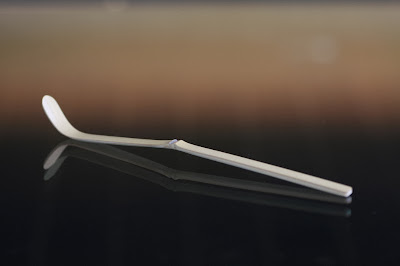“The way to make you happy in 5 minutes” On a TV program on NHK, they introduced how
to make hojicha with such catch
phrase. Hojicha is tea made by roasting sencha
or kukicha. You can buy it from tea shops but you can actually
make one at home by roasting your sencha. I tried what I’ve learned from the TV
program. Did I get happy? Please see what happened.
What
you need:
Iron frying pan (If you don’t have one, you can use a stainless
pot.)
Green tea leaf: 15g (Casual grade sencha 400yen/100g will be fine)
Tips:
First, slowly at low heat
For the finish, rapidly at high heat
1. Pre-heat frying pan for
30 seconds at high heat
2. Place the pan on a damp cloth
for 2 seconds to cool it down a little bit
This makes the pan even in temperature. About 100gC/212F is the ideal temperature.
3. Place the green tea leaves
by spreading into the pan
By placing tea into the pot, colorful green-tea
aroma rises
4. Put the lid on and leave
it for 2 and half minutes.
No fire, residual heat will do.
5. Open the lid
The leaves are still green. I could smell rich fragrance already. It has a green grass note and there seem to be
some other aromas behind it. I wanted to
check them if I can find the various scent like mint, rock salt, flower, chocolate
or orange. But I didn’t have such time
because I had to proceed to the next step before it will be over cooked.
6. Roast
the leaves at high heat for 1 minute while stirring them.
I noticed that the odor was rapidly and continuously
changing from one to another since I started roasting. The green note became a roasted nutty aroma
and then sweet smell. In 20 seconds, it already started smoking. I guess that my stove was too strong. I didn’t know what to do. So, I just turned down the heat to medium and
kept this processes for one minute.
7. When
smoke starts to rise, put off the fire.
Keep
roasting it with the remaining heat for another minute.
At this point, the odor was definitely different
from the beginning. I can acutely find
the smoky aromas like cigar and cinnamon which were mentioned on the TV program.
Here is the pictures for before (top) and
after (below) smoking.
Some leaves have a nice brownish color, but
some small pieces are blackish. I guess the
heat was too strong on the 6th step, so small pieces got over cooked
and burned. Besides that, it went
pretty well. I could not find all the smell that was mentioned
on TV, but I experienced the fresh greenish fragrance changing into various roasted
odor like nuts (hazelnuts??) and chocolate like sweet ones. In the end smoky odor was added which is like
cigar and cinnamon. I had the nice woody
smell not only in the kitchen but also in the living room and other rooms. I asked myself if I’m happy now. I was not sure if I was happy but I definitely
felt good. I loved the aroma of hojicha and was satisfied with the
result. The idea on the TV, “Aroma of
hojicha makes you happy” or “The way to make you happy in 5 minutes” may not be
totally wrong.
There was another advantage! I used old sencha for making this hojicha,
which I didn’t like and didn’t consume much.
It has been kept for a long time at home. But once it was turned into hojicha, it re-lived. I prepared the hojicha and tasted it.
Hojicha:
1.5grams
Boiling water: 80ml (2.8oz)
It was quite good!! I couldn’t believe that it was my least
favorite tea. It is very smooth with a caramelic
sweet flavor which is like a mild black tea without bitterness. Every time I move the cup, the alluring earthy
aroma was pervaded and pleased me. After
drinking, the faint aroma remained around me and my senses were surrounded with
the delight for a while.
Give it a try with your old senecha!
Now as I’m writing this article, I’m drinking hojicha with sugar and milk.
Now, I’m happy!
















































